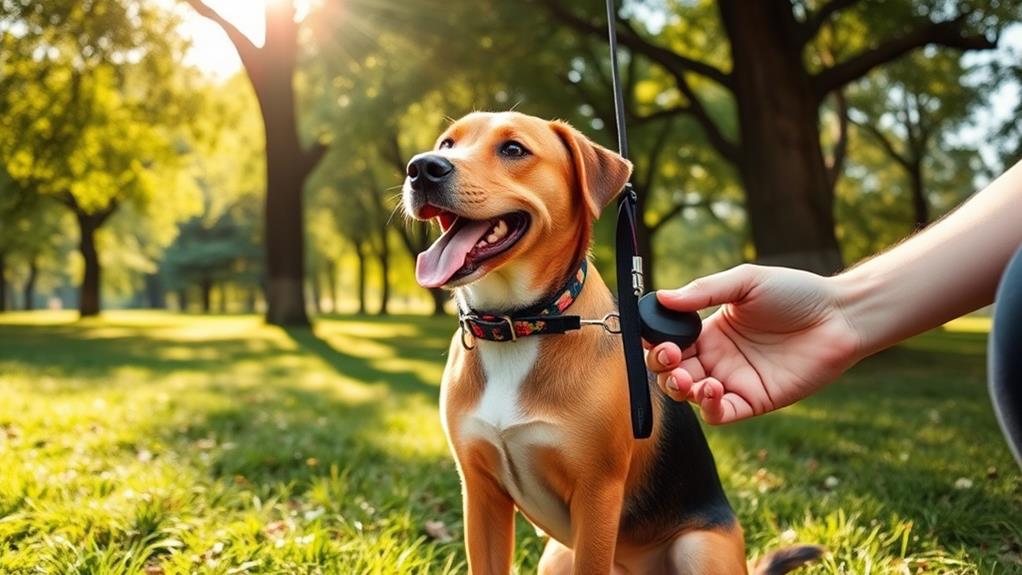Clicker training helps you turn your dog into an obedient companion by using clear signals and positive reinforcement. You'll use a clicker to mark desired behaviors right when they happen, helping your dog connect actions with rewards like treats or praise. This method enhances communication between you and your dog, building trust and a stronger bond. Consistency is vital, so practicing short sessions regularly will yield the best results. With various techniques available, you can tailor your approach to your dog's needs. Keep exploring to discover more effective strategies for transforming your training experience!
Understanding Clicker Training
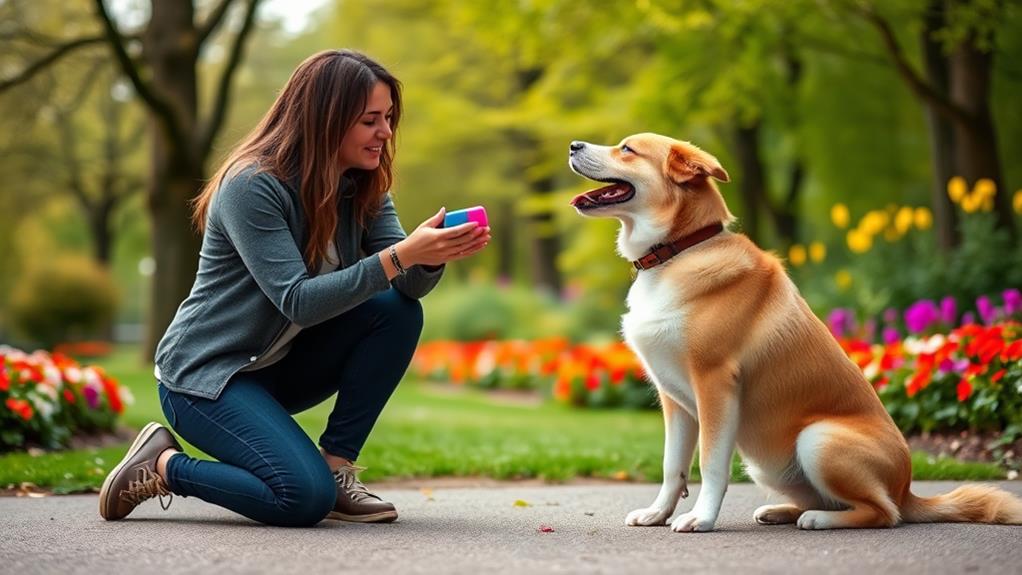
Clicker training is an effective and popular method that many dog owners use to teach their pets new behaviors. This training technique relies on a small device called a clicker, which makes a distinct sound when pressed. When you click the device at the exact moment your dog performs a desired behavior, you're marking that behavior. This helps your dog associate the sound of the clicker with a positive outcome.
To start, you'll need to condition your dog to understand that the click sound means something good is coming. You can do this by clicking and immediately giving them a treat. Once your dog recognizes that the sound signifies a reward, you can begin to incorporate the clicker into your training sessions.
As you work on teaching specific commands or tricks, remember to click right when your dog performs the behavior you want. This helps reinforce the action in their mind. Consistency is indispensable; use the clicker every time they do the desired behavior. With practice, your dog will quickly learn to associate the clicker with positive reinforcement, making it a valuable tool in your training toolkit.
Benefits of Clicker Training
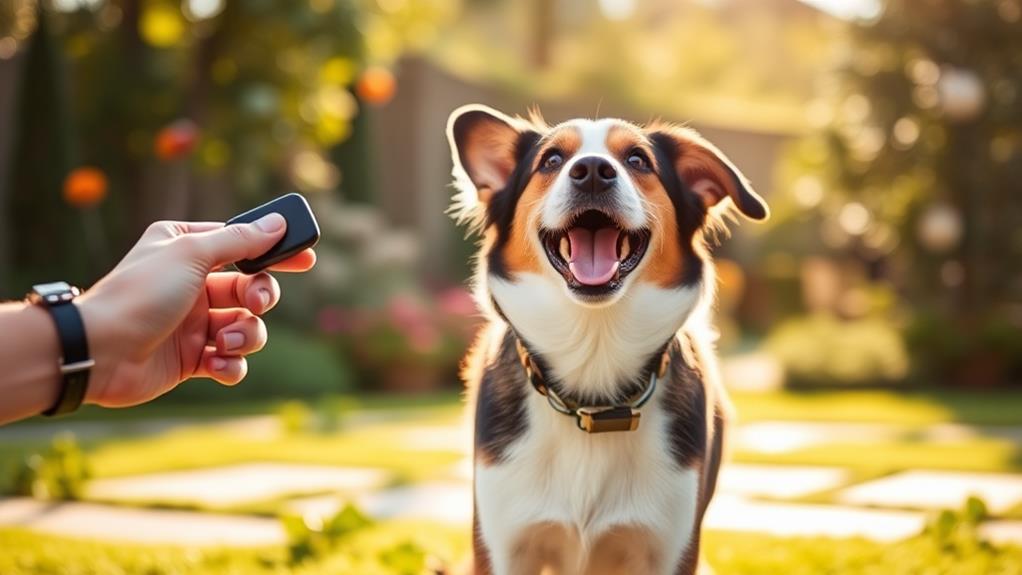
One major advantage of using clicker training is its ability to enhance communication between you and your dog. The clicker provides a clear, consistent signal that marks the desired behavior, making it easier for your dog to understand what you want. This clarity reduces confusion and helps your dog learn more rapidly.
Another benefit is that clicker training fosters positive reinforcement. By associating the sound of the clicker with a reward, you create a positive learning environment. Your dog will likely become more motivated to perform the desired behaviors, leading to quicker results.
Clicker training also builds a stronger bond between you and your dog. As you work together, your dog learns to trust your cues, and you develop a deeper understanding of each other's body language and signals. This mutual respect encourages a more obedient and attentive pet.
Additionally, clicker training can be used for a variety of behaviors, from basic commands to more complex tricks. This versatility allows you to keep training fun and engaging, preventing boredom for both you and your dog. Overall, clicker training offers numerous benefits that can considerably improve your dog's behavior and your relationship.
Essential Clicker Training Tools
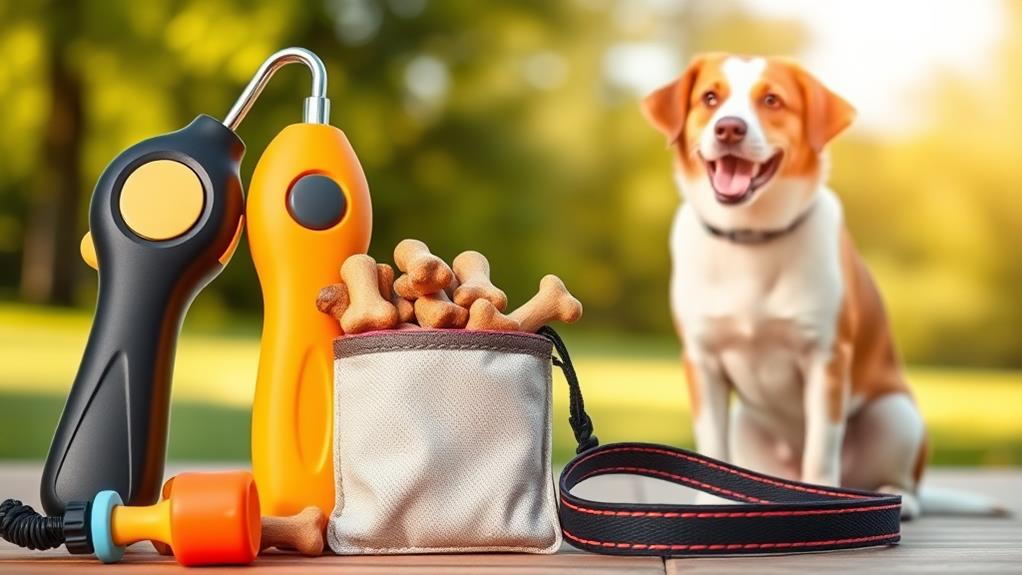
To effectively implement clicker training, you'll need a few key tools to set yourself and your dog up for success. First and foremost is the clicker itself. Choose one that's easy to hold and produces a distinct sound. You want your dog to recognize that sound quickly, so it should be loud enough to capture their attention.
Next, have plenty of tasty treats on hand. Opt for small, soft, and highly palatable rewards, as these will keep your dog engaged and enthusiastic to learn. You might want to try various treats to discover what motivates your dog the most.
In addition to treats, a good leash is essential. A standard six-foot leash works well for training sessions, allowing you to maintain control while giving your dog some freedom to explore.
Lastly, consider having a treat pouch or container. This keeps your treats easily accessible and your hands free for clicker use. With these essential tools, you'll create a positive and effective training environment that encourages your dog to learn and thrive. Happy training!
Basic Clicker Training Techniques
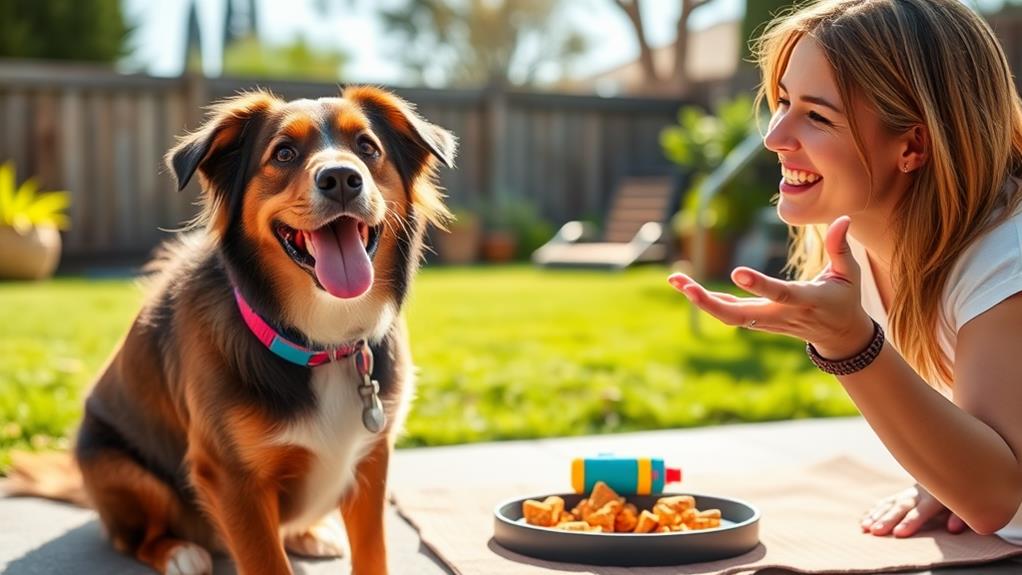
When starting with clicker training, it's indispensable to establish a clear association between the click sound and the behavior you want to reinforce. Begin by using the clicker consistently and pairing it with a reward, like a treat. This helps your dog understand that the click signifies a job well done.
- Choose a Behavior: Pick a simple behavior you want to teach, like "sit" or "down." Make sure it's something your dog can do easily.
- Capture the Moment: When your dog performs the desired behavior, click immediately. Timing is pivotal; the click should happen the moment the behavior occurs.
- Reward: After clicking, give your dog a treat. This reinforces the connection between the action and the reward.
- Practice Regularly: Short, frequent training sessions work best. Aim for 5-10 minutes a few times a day to keep your dog engaged and prevent fatigue.
With consistency and patience, you'll see your dog respond positively to clicker training!
Common Training Mistakes
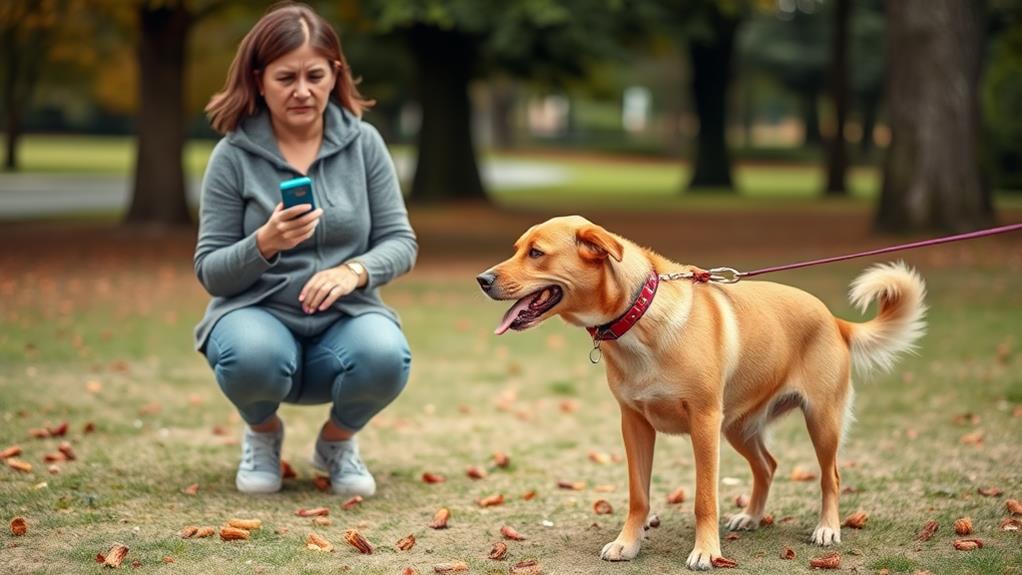
In clicker training, even small mistakes can hinder your progress. One common error is waiting too long to click after your dog performs the desired behavior. If you delay, your dog mightn't connect the click with the action, leading to confusion. Aim to click immediately as the behavior occurs.
Another mistake is using the clicker inconsistently. If you only click sometimes for a behavior, your dog won't understand what you want. Consistency is key, so make sure you click every time your dog performs the desired action until they reliably do it on command.
Misusing treats can also be an issue. If you give treats too often or when your dog isn't performing the behavior, it can dilute the effectiveness of the click. Always pair the click with a reward to reinforce the behavior.
Lastly, avoid training when your dog is distracted or overly excited. This can lead to frustration for both of you. Choose a quiet environment where your dog can focus, making it easier for them to learn. By avoiding these common mistakes, you'll create a more effective and enjoyable training experience for both you and your dog.
Advanced Clicker Training Strategies
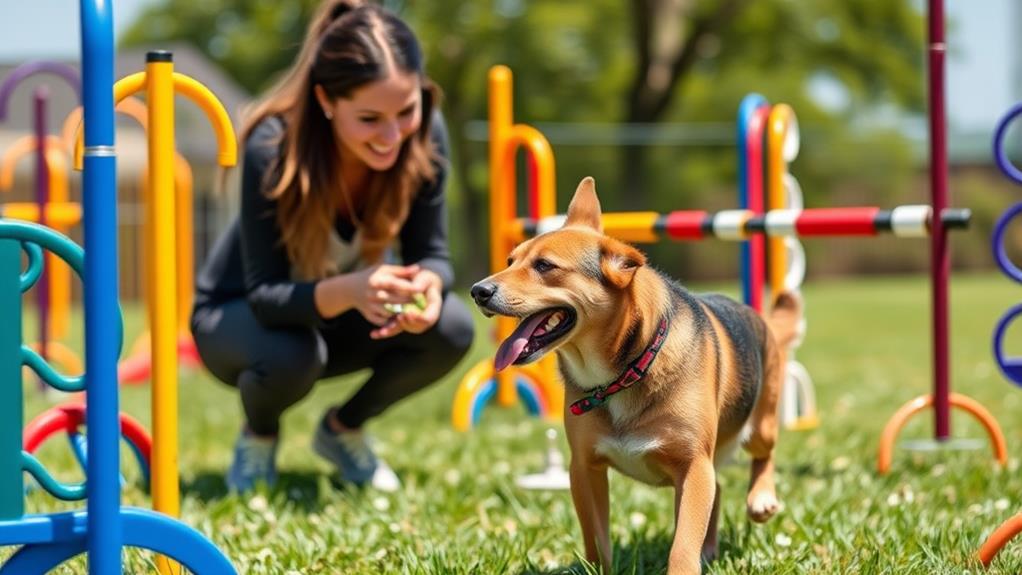
How can you elevate your clicker training experience to the next level? Advanced clicker training strategies can help you refine your skills and deepen your bond with your dog.
- Shaping: Break down complex behaviors into smaller steps. Click and reward your dog for each incremental step toward the final behavior. This method encourages creativity and problem-solving.
- Variability in Rewards: Instead of always providing a treat, mix it up with praise, toys, or playtime. This keeps your dog engaged and enthusiastic to perform, as they won't know what to expect.
- Generalization: Train your dog in various locations and situations. This helps them learn to apply commands in diverse environments, solidifying their understanding.
- Latent Learning: Introduce new cues without immediate reinforcement. Let your dog explore the new behavior, then click and reward when they perform it later. This encourages them to think independently and reinforces learning over time.
Integrating Clicker Training in Daily Life
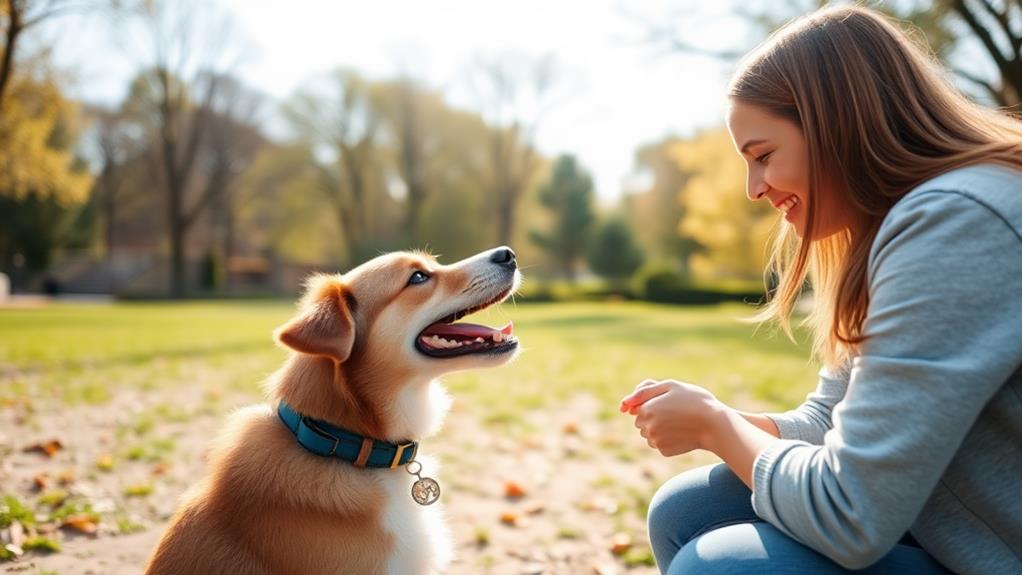
Integrating clicker training into your daily routine can transform ordinary moments into opportunities for learning and bonding with your dog. You don't need to set aside special training sessions; instead, use everyday situations to reinforce good behavior.
Consider these simple scenarios:
| Activity | Training Focus |
|---|---|
| Walking on a leash | Reward your dog for staying close and not pulling. |
| Mealtime | Click and treat when your dog waits patiently before eating. |
| Visitors arriving | Click when your dog remains calm instead of jumping. |
Incorporating clicker training during these moments not only enhances your dog's obedience but also strengthens your relationship. You'll find that consistency is key. Keep the clicker handy and be ready to reward your dog whenever they display the desired behavior.
Monitoring Progress and Adjusting Techniques
As you incorporate clicker training into your daily life, it's important to keep an eye on your dog's progress and adjust your techniques as needed. Monitoring their development helps you identify what's working and what isn't, allowing for a more tailored approach to training.
Track Commands: Keep a log of the commands your dog has mastered and those they struggle with. This will help you focus your training sessions on specific areas.
Observe Behavior: Watch your dog closely during training sessions. Are they enthusiastic to participate, or do they seem bored or frustrated? Their body language can provide valuable insights.
Adjust Rewards: If your dog isn't responding well, consider changing the type or frequency of rewards. Some dogs may thrive on treats, while others might prefer playtime or praise.
Be Patient: Remember that every dog learns at their own pace. If progress stalls, take a step back and reassess your approach, ensuring it aligns with your dog's needs.
Frequently Asked Questions
Can Clicker Training Be Used for Other Pets Besides Dogs?
Yes, clicker training can work for other pets, too! You can successfully use it with cats, birds, and even small mammals. It helps reinforce positive behaviors and strengthens your bond with them while teaching new tricks.
How Long Does It Take to See Results With Clicker Training?
How long do you think it takes to see results with clicker training? Typically, you'll notice changes within a few sessions, but consistent practice is key for solidifying those behaviors over time. Keep it fun!
Is Clicker Training Suitable for Aggressive Dogs?
Yes, clicker training can be suitable for aggressive dogs. You'll need to approach it carefully, focusing on positive reinforcement and gradually desensitizing them to triggers. Patience and consistency will help you see progress over time.
What Should I Do if My Dog Doesn't Respond to the Clicker?
If your dog's ignoring the clicker, don't despair; it's a bump in the road. Try using higher-value treats, reducing distractions, or ensuring your timing's spot-on. Patience and consistency will guide you both forward.
Can I Use Treats Instead of a Clicker?
Yes, you can definitely use treats instead of a clicker. Just guarantee you're consistent with your timing and rewards. Positive reinforcement works well, so make certain to praise your dog when they respond correctly.
Conclusion
Incorporating clicker training into your dog's routine not only enhances obedience but also strengthens your bond. Did you know that studies show clicker-trained dogs can learn commands up to 20% faster than those trained by traditional methods? By utilizing this powerful tool consistently and creatively, you'll witness remarkable progress in your dog's behavior. So, keep practicing, stay patient, and watch your furry friend thrive with the joy of learning and your guidance!

